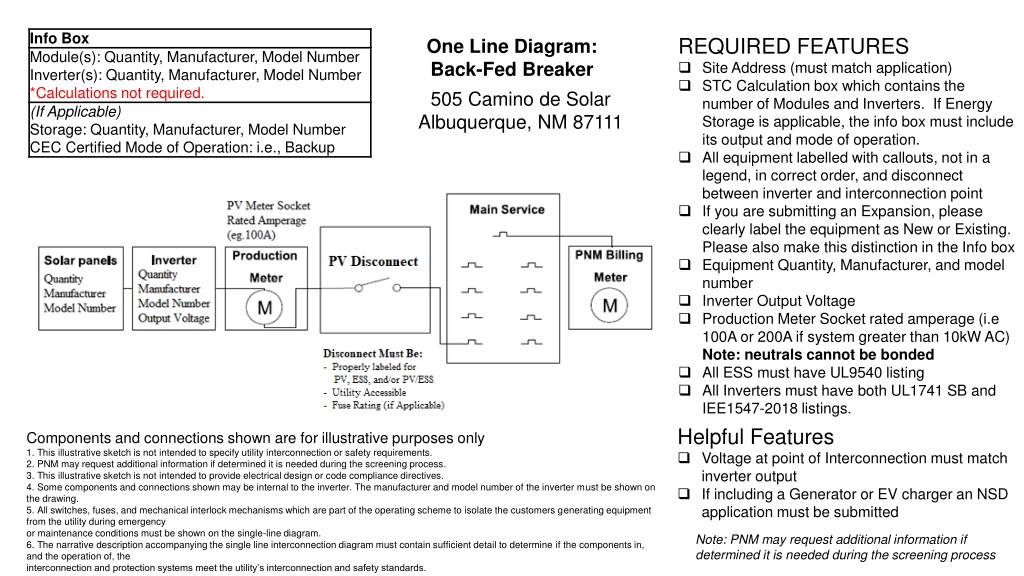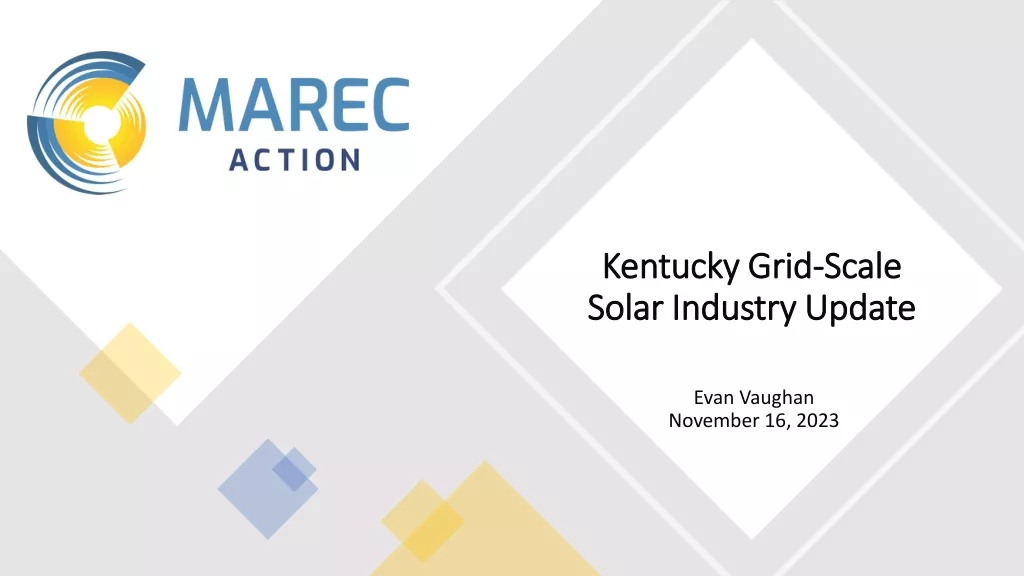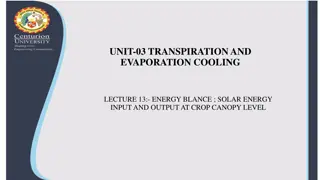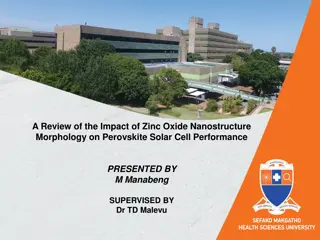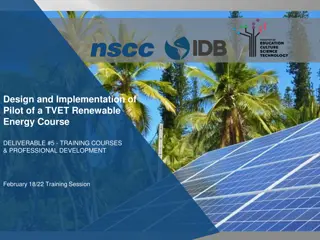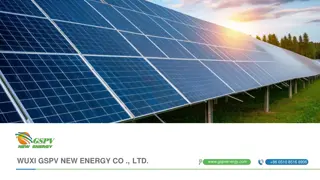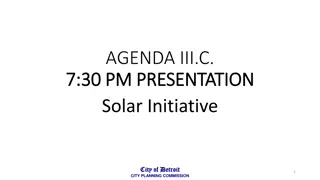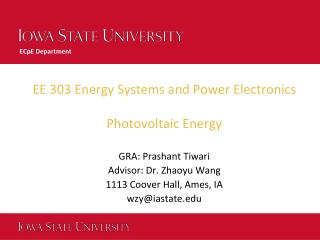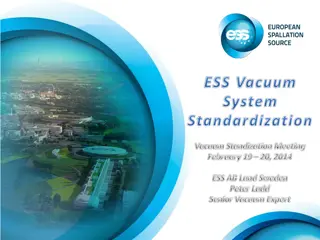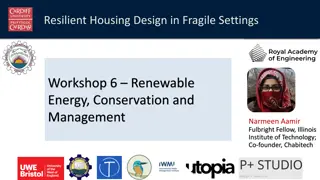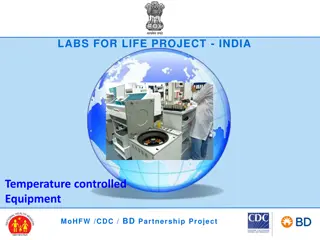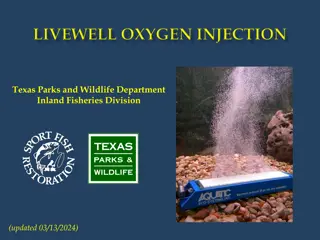Solar Energy System Equipment Requirements and Installation Guidelines
This document outlines the essential equipment requirements and installation guidelines for a solar energy system, including modules, inverters, storage, and one-line diagrams. It emphasizes compliance with safety standards, necessary certifications, and proper detailing of components and connections. The provided information is crucial for accurate system design and utility interconnection.
Download Presentation
Please find below an Image/Link to download the presentation.
The content on the website is provided AS IS for your information and personal use only. It may not be sold, licensed, or shared on other websites without obtaining consent from the author. Download presentation by click this link. If you encounter any issues during the download, it is possible that the publisher has removed the file from their server.
Presentation Transcript
Info Box Module(s): Quantity, Manufacturer, Model Number Inverter(s): Quantity, Manufacturer, Model Number *Calculations not required. (If Applicable) Storage: Quantity, Manufacturer, Model Number CEC Certified Mode of Operation: i.e., Backup REQUIRED FEATURES Site Address (must match application) STC Calculation box which contains the number of Modules and Inverters. If Energy Storage is applicable, the info box must include its output and mode of operation. All equipment labelled with callouts, not in a legend, in correct order, and disconnect between inverter and interconnection point If you are submitting an Expansion, please clearly label the equipment as New or Existing. Please also make this distinction in the Info box Equipment Quantity, Manufacturer, and model number Inverter Output Voltage Production Meter Socket rated amperage (i.e 100A or 200A if system greater than 10kW AC) Note: neutrals cannot be bonded All ESS must have UL9540 listing All Inverters must have both UL1741 SB and IEE1547-2018 listings. Helpful Features Voltage at point of Interconnection must match inverter output If including a Generator or EV charger an NSD application must be submitted One Line Diagram: Back-Fed Breaker 505 Camino de Solar Albuquerque, NM 87111 Components and connections shown are for illustrative purposes only 1. This illustrative sketch is not intended to specify utility interconnection or safety requirements. 2. PNM may request additional information if determined it is needed during the screening process. 3. This illustrative sketch is not intended to provide electrical design or code compliance directives. 4. Some components and connections shown may be internal to the inverter. The manufacturer and model number of the inverter must be shown on the drawing. 5. All switches, fuses, and mechanical interlock mechanisms which are part of the operating scheme to isolate the customers generating equipment from the utility during emergency or maintenance conditions must be shown on the single-line diagram. 6. The narrative description accompanying the single line interconnection diagram must contain sufficient detail to determine if the components in, and the operation of, the interconnection and protection systems meet the utility s interconnection and safety standards. Note: PNM may request additional information if determined it is needed during the screening process
REQUIRED FEATURES Site Address (must match application) STC Calculation box which contains the number of Modules and Inverters. If Energy Storage is applicable, the info box must include its output and mode of operation All equipment labelled with callouts, not in a legend, in correct order, and disconnect between inverter and interconnection point If you are submitting an Expansion, please clearly label the equipment as New or Existing. Please also make this distinction in the Info box Equipment Quantity, Manufacturer, and model number Inverter output Voltage All ESS must have UL9540 listing All Inverters must have both UL1741 SB and IEE1547-2018 Helpful Features Voltage at point of Interconnection must match inverter output If including a Generator or EV charger an NSD application must be submitted Info Box Module(s): Quantity, Manufacturer, Model Number Inverter(s): Quantity, Manufacturer, Model Number *Calculations not required. (If Applicable) Storage: Quantity, Manufacturer, Model Number CEC Certified Mode of Operation: i.e., Backup One Line Diagram: Back-Fed Breaker For systems at or under 10kW AC 505 Camino de Solar Albuquerque, NM 87111 Components and connections shown are for illustrative purposes only 1. This illustrative sketch is not intended to specify utility interconnection or safety requirements. 2. PNM may request additional information if determined it is needed during the screening process. 3. This illustrative sketch is not intended to provide electrical design or code compliance directives. 4. Some components and connections shown may be internal to the inverter. The manufacturer and model number of the inverter must be shown on the drawing. 5. All switches, fuses, and mechanical interlock mechanisms which are part of the operating scheme to isolate the customers generating equipment from the utility during emergency or maintenance conditions must be shown on the single-line diagram. 6. The narrative description accompanying the single line interconnection diagram must contain sufficient detail to determine if the components in, and the operation of, the interconnection and protection systems meet the utility s interconnection and safety standards. Note: PNM may request additional information if determined it is needed during the screening process
REQUIRED FEATURES Site Address (must match application) STC Calculation box which contains the number of Modules and Inverters. If Energy Storage is applicable, the info box must include its output and mode of operation All equipment labelled with callouts, not in a legend, in correct order, and disconnect between inverter and interconnection point. If you are submitting an Expansion, please clearly label the equipment as New or Existing. Please also make this distinction in the Info box Equipment Quantity, Manufacturer, and model number Inverter output Voltage Production Meter Socket rated amperage (i.e 100A or 200A if system greater than 10kW AC) Note: neutrals cannot be bonded All Inverters must have both UL1741 SB and IEE1547-2018 Line side taps are not allowed with ESS systems Helpful Features Voltage at point of Interconnection must match inverter output If including a Generator or EV charger an NSD application must be submitted One Line Diagram: Line Side Tap 505 Camino de Solar Albuquerque, NM 87111 Info Box Module(s): Quantity, Manufacturer, Model Number Inverter(s): Quantity, Manufacturer, Model Number *Calculations not required. *Line side taps not allowed with ESS systems Note: PNM may request additional information if determined it is needed during the screening process Components and connections shown are for illustrative purposes only 1. This illustrative sketch is not intended to specify utility interconnection or safety requirements. 2. PNM may request additional information if determined it is needed during the screening process. 3. This illustrative sketch is not intended to provide electrical design or code compliance directives. 4. Some components and connections shown may be internal to the inverter. The manufacturer and model number of the inverter must be shown on the drawing. 5. All switches, fuses, and mechanical interlock mechanisms which are part of the operating scheme to isolate the customers generating equipment from the utility during emergency or maintenance conditions must be shown on the single-line diagram. 6. The narrative description accompanying the single line interconnection diagram must contain sufficient detail to determine if the components in, and the operation of, the interconnection and protection systems meet the utility s interconnection and safety standards.
REQUIRED FEATURES Site Address (must match application) STC Calculation box which contains the number of Modules and Inverters. If Energy Storage is applicable, the info box must include its output and mode of operation All equipment labelled with callouts, not in a legend, in correct order, and disconnect between inverter and interconnection point If you are submitting an Expansion, please clearly label the equipment as New or Existing. Please also make this distinction in the Info box Equipment Quantity, Manufacturer, and model number If V2G functionality is desired, EV charger must be depicted in diagrams and application. Inverter output Voltage Production Meter Socket rated amperage (i.e.100A or 200A if system greater than 10kW AC) Note: neutrals cannot be bonded All ESS must have UL9540 listing All Inverters must have both UL1741 SB and IEE1547- 2018 Helpful Features Voltage at point of Interconnection must match inverter output If including a Generator or EV charger an NSD application must be submitted One Line Diagram: An Expansion example Info Box Existing (E) Module(s): Quantity, Manufacturer, Model Number Inverter(s): Quantity, Manufacturer, Model Number New (N) Module(s) Quantity, Manufacturer, Model Number Inverter(s): Quantity, Manufacturer, Model Number *Calculations not required. *Line side taps not allowed with ESS systems (If Applicable) Storage: Quantity, Manufacturer, Model Number Mode of Operation: i.e., Backup 505 Camino de Solar Albuquerque, NM 87111 Note: PNM may request additional information if determined it is needed during the screening process
Future Information For 3-phase systems Three Line Diagram is required A Three-line diagram may be requested be reviewers as deemed necessary. For Large (>10 kW AC) and/or 3-phase systems: Please include reference to PNM Meter Standard Production meter Socket must be rated at least 200A For Battery Backup or Energy Storage Systems, please refer to PNM Interconnection and Safety Standards as well. All diagrams are evaluated to ensure compliance with PNM metering and Interconnection and Safety Standards. This evaluation does not imply NEC compliance. For Interconnection and Safety Standards, please visit https://www.pnm.com/interconnecting-small-facilities https://www.pnm.com/interconnecting-large-facilities For technical requirements for interconnecting Distributed Energy Resources (DER) to PNM s electric distribution system please see PNM s Technical Interconnection and Interoperability Requirements (TIIR) PNM Technical Interconnection and Interoperability Requirements
